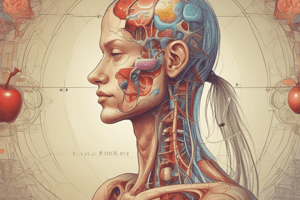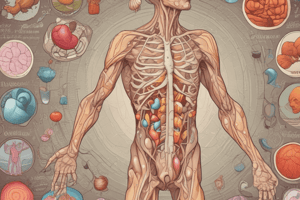Podcast
Questions and Answers
What are the primary functions of a cell?
What are the primary functions of a cell?
The primary functions of a cell include metabolic activities, energy production, and maintaining homeostasis through membrane transport.
Describe the phases of gastric secretion involved in digestion.
Describe the phases of gastric secretion involved in digestion.
The phases of gastric secretion include the cephalic phase, gastric phase, and intestinal phase, each regulated by neural and hormonal signals.
Discuss the differences between innate and adaptive immunity.
Discuss the differences between innate and adaptive immunity.
Innate immunity is non-specific and immediate, while adaptive immunity is specific and develops over time in response to pathogens.
What role does the nephron play in the formation of urine?
What role does the nephron play in the formation of urine?
How does membrane transport contribute to cellular function?
How does membrane transport contribute to cellular function?
Explain the significance of neuromuscular transmission.
Explain the significance of neuromuscular transmission.
Identify factors influencing blood pressure regulation.
Identify factors influencing blood pressure regulation.
What is the function of the heart in the overall circulatory system?
What is the function of the heart in the overall circulatory system?
What is the function of hunger and satiety centers in the regulation of food intake?
What is the function of hunger and satiety centers in the regulation of food intake?
Describe the role of antibodies in the immune response.
Describe the role of antibodies in the immune response.
What factors influence blood pressure regulation?
What factors influence blood pressure regulation?
Explain the process of gas exchange in the lungs.
Explain the process of gas exchange in the lungs.
What are the main functions of the nephron in the excretory system?
What are the main functions of the nephron in the excretory system?
Describe the structure and function of the pituitary gland.
Describe the structure and function of the pituitary gland.
What are the roles of the central and peripheral nervous systems?
What are the roles of the central and peripheral nervous systems?
How does the process of spermatogenesis occur?
How does the process of spermatogenesis occur?
What is the primary function of the brain in the central nervous system?
What is the primary function of the brain in the central nervous system?
Describe the effect of parasympathetic stimulation on heart rate.
Describe the effect of parasympathetic stimulation on heart rate.
List the major endocrine glands and one primary function of each.
List the major endocrine glands and one primary function of each.
Explain the feedback mechanism involved in regulating insulin secretion.
Explain the feedback mechanism involved in regulating insulin secretion.
What is the role of hormones in the reproductive process?
What is the role of hormones in the reproductive process?
How do the nervous and endocrine systems interact to maintain homeostasis?
How do the nervous and endocrine systems interact to maintain homeostasis?
What is the significance of membrane potential in nerve cells?
What is the significance of membrane potential in nerve cells?
Describe how muscle contraction is initiated at the neuromuscular junction.
Describe how muscle contraction is initiated at the neuromuscular junction.
How does the mapping of Course Outcomes (CO) to Program Outcomes (PO) reflect the effectiveness of a laboratory textbook in anatomy and physiology?
How does the mapping of Course Outcomes (CO) to Program Outcomes (PO) reflect the effectiveness of a laboratory textbook in anatomy and physiology?
What role does the concept of lifelong learners play in the presentation of the learning outcomes from the provided educational resources?
What role does the concept of lifelong learners play in the presentation of the learning outcomes from the provided educational resources?
Discuss the significance of ethical reasoning in the context of anatomy and physiology education based on the information provided.
Discuss the significance of ethical reasoning in the context of anatomy and physiology education based on the information provided.
In what way does the institution encourage critical inquiry through its learning outcomes?
In what way does the institution encourage critical inquiry through its learning outcomes?
Identify two educational resources listed and explain their relevance to the study of exercise physiology.
Identify two educational resources listed and explain their relevance to the study of exercise physiology.
What is the function of mapping Course Outcomes (CO) to Program Specific Outcomes (PSO) in an educational setting?
What is the function of mapping Course Outcomes (CO) to Program Specific Outcomes (PSO) in an educational setting?
How do the learning resources contribute to the development of communication skills among students?
How do the learning resources contribute to the development of communication skills among students?
Explain the impact of technological integration in anatomy and physiology education based on the provided resources.
Explain the impact of technological integration in anatomy and physiology education based on the provided resources.
What implications does the focus on teamwork in the mapping of CO and PO have for future healthcare professionals?
What implications does the focus on teamwork in the mapping of CO and PO have for future healthcare professionals?
Analyze how the inclusion of a variety of textbooks influences the foundational knowledge in anatomy and physiology.
Analyze how the inclusion of a variety of textbooks influences the foundational knowledge in anatomy and physiology.
Flashcards are hidden until you start studying
Study Notes
Human Physiology Overview
- Course focuses on the understanding of human anatomy and physiology.
- Key components include the integrated functioning of cells, tissues, organs, and systems.
- Aims to explain the structure and functions of major human organs essential for health.
Learning Objectives
- Understand human anatomy and physiology fundamentals.
- Comprehend the functional interrelationship among body components vital for life.
- Describe the anatomy of organs and relate their functions to health maintenance.
Course Outcomes
- Students will articulate cellular structure, functions, cell regulation, and transport mechanisms.
- Recall and analyze the digestive process, nutrient absorption and the regulation of food intake.
- Differentiate types of immunity, cardiovascular structures, and interpret ECG readings.
- Explain nephron structure, urine formation, and the functioning of the central and peripheral nervous systems.
- Identify endocrine glands, their hormonal functions, and the reproductive system processes.
Syllabus Breakdown
Unit I: Physiology of Cell, Cell Membrane, Nerve, and Muscle
- Emphasizes cellular organization, structure-function relationships, and cell division.
- Discusses membrane transport mechanisms such as diffusion, active transport, and membrane potentials.
- Covers neuromuscular junctions and the coupling of excitation and contraction in skeletal muscles.
Unit II: Digestive System
- Review of the gastrointestinal tract including liver, pancreas, and gall bladder functions.
- Motility within the GIT and its hormonal regulation.
- Insights into the hunger and satiety centers and the impact of nutrients on food intake.
Unit III: Immune, Cardiovascular, and Respiratory System
- Explains cell-mediated and humoral immunity, with antibody production's role in defense.
- Structure-function relationships within the heart, blood vessels, and the cardiac cycle.
- Describes respiratory system functions, gas exchange mechanisms, and regulatory processes.
Unit IV: Excretory and Nervous System
- Nephron anatomy and urine formation processes.
- Functions of the renal system in blood pH balance.
- Overview of the central and peripheral nervous systems, including structures and functions of the brain and spinal cord.
Unit V: Endocrine and Reproductive System
- Structure and function of major endocrine glands like the pituitary, thyroid, and adrenal glands.
- Regulatory mechanisms governing hormone secretion and their physiological impacts.
- Studies the reproductive systems highlighting spermatogenesis, ovulation, and hormonal roles in reproduction.
Assessment and Mapping
- Course is assessed on knowledge, skills, and competencies, mapped to Programme Outcomes (POs) and Programme Specific Outcomes (PSOs).
- Uses a scale of Strong (S), Moderate (M), and Weak (W) for abilities in various competencies.
Learning Resources
- Textbooks ranging from Essentials of Human Physiology to specific texts on Anatomy and Physiology.
- E-learning and online resources available for enhanced learning experience.
Studying That Suits You
Use AI to generate personalized quizzes and flashcards to suit your learning preferences.




